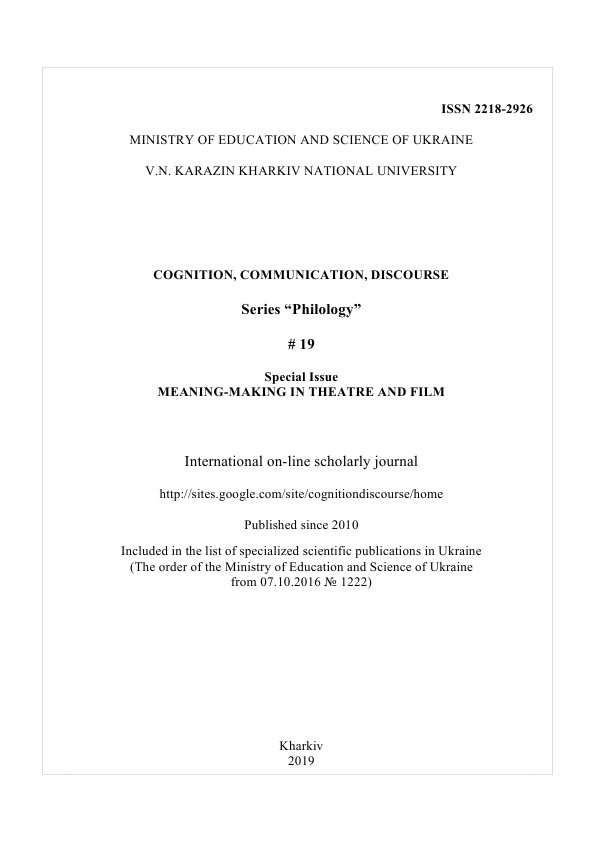Theme of madness in a short story “The System of Doctor Tarr and Professor Fether” by Edgar Allan Poe and in a similarly-named film by Claude Chabrol
Abstract
The article considers the theme of madness as a cultural phenomenon in its romantic (Edgar Poe) and postmodern (Claude Chabrol) film interpretation. The study is based on the cultural and philosophical concept of madness grounded by Michel Foucault. The historical existence of madness phenomenon has two types of its perception distinguished, ‘cosmic’, which is the tragic madness of the world, and ‘critical’, which is peculiar to human consciousness and behavior, generating the ironic understanding. According to the philosopher, the cosmic and critical cultural experience of madness is embodied in visually plastic (pictorial) and verbal (literary) forms respectively. The verbal and literary specifics of creating an aesthetic image of madness within the romantic canon in Edgar Allan Poe’s story is compared with the peculiarities of the visual-sound plastic form of the images in Claude Chabrol’s film, created in the style of surrealism. In Poe’s story madness appears as a local phenomenon, a state of human consciousness determining the way of thinking and the specifics of behavior. The main way how the writer creates the characters includes their behavioral characteristics and speech. In Chabrol’s film interpretation the theme of madness unfolds gradually, being embodied in visual images, the pace of the film, the changing intraframe composition, the specific movement in the frame, the speed and rhythm of cutting, the color and sound of the film. Within the postmodernism aesthetics the director, inserting surrealistic Buñuel’s intertext, using the techniques of playing with the audience and varying interpretations of the end, focuses on the cosmic experience of madness, transforming Poe’s romantic-ironic interpretation into a understanding the “tragic madness of the world”.
Downloads
References
Bryant, J. (1996). Poe ape of Unreason – Humor, Ritual, and Culture. Nineteenth-Century Literature, 51(1), pp. 16-52. DOI: https://doi.org/10.2307/2933839 .
Chabrol, C. (Director). (1981). Le Système Du Docteur Goudron Et Du Professeur Plume [Television series episode]. In Histoires Extraordinaires [Extraordinary Stories]. France Regions 3
Cleman, J. (1991). Irresistible Impulses – Poe Edgar Allan and the Insanity Defense. American Literature, 63(4), pp. 623-640. DOI: https://doi.org/10.2307/2926871 .
Drabeck, B. A. (1972). “Tarr and Fether” – Poe and Abolitionism. American Transcendental Quarterly: A Journal of New England Writers, 14, 177-184.
Foucault, M. (2006). Madness and Civilization: A History of Insanity in the Age of Reason. London & New York: Routledge.
Frank, L. (1995). The “Murders in the Rue Morgue” – Poe Edgar Allan Evolutionary Reverie. Nineteenth-Century Literature, 50(2), 168-188.
DOI: https://doi.org/10.1525/ncl.1995.50.2.99p01497 .
Kovalev, Yu. V. (1984). Jedgar Allan Po. Novellist i pojet [Edgar Allan Po. The short-story writer and the poet]. Leningrad: Hudozhestvennaja literatura Publ. (In Russian)
Mikheeva, L. (2015). Mocart. Simfonija No. 35 («Haffnerovskaja») [Mozart. Symphony No. 35 (“Haffner’s”)]. Retrieved frоm: http://www.belcanto.ru/s_ mozart_35.html (In Russian).
Miranda, M. D. (2017). Reasoning through madness: the detective in Gothic crime fiction. Palgrave Communications, 3. Retrieved from: https:// www.nature.com/articles/palcomms201745.pdf DOI: https://doi.org/10.1057/palcomms.2017.45 .
Percich, A. M. (2014). Irish Mouths and English Tea-pots: Orality and Unreason in “The System of Doctor Tarr and Professor Fether”. Poe Studies-History Theory Interpretation, 47, 76-99. DOI: https://doi.org/10.1353/poe.2014.0014 .
Pizarro, O. F. (2011). Transformations and new expressions of nervousness in the construction of Edgar Allan Poe's short stories. Acta Literaria, 43, 79-93.
DOI: https://doi.org/10.4067/S0717-68482011000200006 .
Poe, E. A. (2016). The System of Doctor Tarr and Professor Fether. In The Works of Edgar Allan Poe. Volume 4 (of 5) of the Raven Edition. Retrieved from: https://www.gutenberg.org/files/2150/2150-h/2150-h.htm#link2H_4_0005
Sievers, B. (1999). Psychotic organization as a metaphoric frame for the socioanalysis of organizational and interorganizational dynamics. Administration & Society, 31(5), 588-615. DOI: https://doi.org/10.1177/00953999922019256 .
Ward, P. (2005). Picture Composition for Film and Television. London: Focal Press.
Wellek, R., Warren, A. (1949). Theory of Literature. New York: Harcourt, Brace and Company.
Copyright (c) 2019 Stepanova Anna

This work is licensed under a Creative Commons Attribution-NonCommercial-NoDerivatives 4.0 International License.
Authors, who publish with this journal, accept the following conditions:
The authors reserve the copyright of their work and transfer to the journal the right of the first publication of this work under the terms of the Creative Commons Attribution License (CC BY), which allows other persons to freely distribute a published work with mandatory reference to the authors of the original work and the first publication of the work in this journal.
Authors have the right to enter into separate additional agreements for the non-exclusive dissemination of the work in the form in which it was published by this journal (for example, to post the work in the electronic institutions' repository or to publish as part of a monograph), provided that the link to the first publication of the work in this journal is given.
The journal policy allows and encourages the authors to place the manuscripts on the Internet (for example, in the institutions' repositories or on personal websites), both before the presentation of this manuscript to the editorial board and during review procedure, as it contributes to the creation of productive scientific discussion and positively affects the efficiency and dynamics of citing the published work (see The Effect of Open Access).




